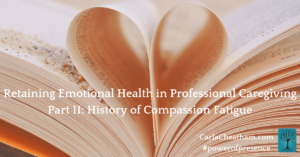This is an on-going series from my presentations on the use of ethical boundaries and resilience to maintain both healthy professionals and teams as well as prevent compassion fatigue and burnout.
Professionals in caregiving fields are hungry for information to help them maintain a healthy balance in their work. Managers are desperate to know how to support functional teams. We’re all seeking solutions.
In 2013, the National Hospice and Palliative Care Organization’s Spiritual Caregiver Section performed a survey of SCCs and their managers from member agencies across the U.S. See the writeup on pp 16-27 in NHPCO’s January 2014 NewsLine.
Over 1,000 respondents chose their top 5 picks for continuing education. The second most requested was “Preventing and responding to compassion fatigue for hospice staff (and self)” (43% Total; 44% SCCs; 39% Managers).
While there may be no quick and easy fix to one of the primary hazards of professional caregiving, there are steps we can take to support ourselves, and each other, and prevent compassion fatigue. First, it’s helpful to know what it even is and a bit about the history of our understanding.
History of Our Growing Understanding
The term burnout was perhaps first heard in the 1960 Graham Green novel, A Burnt-Out Case. In the 1970s, clinical psychologist, Herbert Freudenberger, first discussed the phenomenon of burnout (Freudenberger, 1974).
Early researchers, Maslach and Jackson, postulated it arose from a 12-phase process that included excessive ambition, self-neglect, denial, withdrawal, depression and more until it resulted in full-on burnout. To assess for this, they developed the Maslach Burnout Inventory (Maslach, Jackson, & Leiter 1996).
It was once considered to be about “people jobs”, but over time research found it was more about work overload, values conflict, and a lack of reward, community, fairness, and control, with this last one being of particular impact (Maslach, Schaufeli, & Leiter, 2001).
According to Maslach, burnout involves exhaustion, cynicism, and inefficacy in our work. Feeling out of control of one’s situation only magnifies the impact we feel.
Related to Maslach’s findings about the impact of values conflict, Andrew Jameton explored “moral distress”, which arises when one knows the right action but is in some way constrained from taking it (Jameton, 1984).
Other terms arose during these years of early exploration, such as post-traumatic stress disorder and secondary traumatic stress disorder. Finally, Charles Figley introduced compassion fatigue (1995).
Compassion Fatigue as an Overarching Framework
There are distinguishing factors, clinically, amongst these various terms, but for the sake of brevity, I speak of each in the following general terms—burnout is about exhaustion and a feeling of disillusionment and helplessness, moral distress is about wanting to help but not being able to, compassion fatigue is about wanting to help but having inadequate energy left to do so, and the more vicarious traumas are about feeling the pain with patients and families.
With all of them we may see fatigue, depression, anger; feelings of ineffectiveness, apathy, and/or detachment; physiological symptoms such as headaches, insomnia, and gastrointestinal distress. Surprisingly, nurses appear to be amongst those most likely to miss physical symptoms as being a sign of their own stress.
Increasingly, compassion fatigue has become the generalized, overarching term seen in the literature to describe what it is so many of us can experience in various forms over the course of our lives and careers. For ease of discussion, I will also use this term rather globally throughout the series.
What is Compassion Fatigue?
According to one well-respected expert on compassion fatigue, it is:
“a progressive state of emotional unease. It evolves from compassion discomfort, to compassion stress, and finally to compassion fatigue, a state where the compassion energy that is expended by nurses surpasses their ability to recover from this energy expenditure, resulting in significant negative psychological and physical consequences.” (Boyle, 2011)
It is a deterioration in empathy and sensitivity to suffering that can arise at home and/or at work or it can even present as an over-reaction to suffering. In whichever extreme it manifests, it can lead to poor performance at work, anger and resentment over seemingly trivial matters, and a distrust of and struggles with the perceived system, such as management, leading to the suffering.
Most often, compassion fatigue is a gradual, progressive process that stems from exposure to on-going job strain which can lead to an erosion of idealism and a view that one is not achieving one’s professional achievements. Figley, another prominent expert on the topic, called it a “state of exhaustion and dysfunction biologically, psychologically, and socially—as a result of prolonged exposure to stress.” (1995, p. 253).
It can seem overwhelming and hopeless when one is feeling their compassion muscles have worn out or been dealt a blow or when we are working with others who are experiencing such fatigue. However, with an understanding of the factors that put us most at risk and the symptoms that alert us that compassion fatigue is present, we can prevent and intervene before the impact becomes long-lasting or detrimental.
In next week’s post, I’ll discuss the risks and symptoms and, as the series continues in the following weeks, lay out a way of being that can provide protection and healing for us all. For now, please be gentle with yourselves, and each other.
For what it’s worth.
Peace,
Carla
Boyle, DA (2011). “Countering Compassion Fatigue: A Requisite Nursing Agenda” The Online Journal of Issues in Nursing, Vol 16 (1).
Figley, C. (1995). Compassion Fatigue: Coping with Secondary Traumatic Stress in Those Who Treat the Traumatized, Brunner-Routledge, London.
Freudenberger, H. J. (1974). Staff burnout. Journal of Social Issues, 30(1), 159-165.
Jameton, A. (1984). Nursing practice: The ethical issues. Englewood Cliffs, NJ: Prentice-Hall.
Maslach, C., Jackson, S.E, & Leiter, M.P. MBI: The Maslach Burnout Inventory: Manual. Palo Alto: Consulting Psychologists Press, 1996.
Maslach, C.; Schaufeli, W. B.; Leiter, M. P. (2001). “Job burnout”. In S. T. Fiske, D. L.
 Rev. Carla Cheatham, MA, MDiv, PhD, TRT has served hospices as a chaplain and bereavement coordinator. She’s the Section Leader for the Spiritual Caregivers Section of the National Hospice and Palliative Care Organization and an adjunct professor at the Seminary of the Southwest. Through her Carla Cheatham Consulting Group, Carla provides training and consulting for professional caregivers nationwide. She is the author of Hospice Whispers: Stories of Life and its companion volume, Sharing Our Stories: A Hospice Whispers Grief Support Workbook. Her next book, On Showing Up with Suffering: Others’ and Our Own, is set to publish in 2017.
Rev. Carla Cheatham, MA, MDiv, PhD, TRT has served hospices as a chaplain and bereavement coordinator. She’s the Section Leader for the Spiritual Caregivers Section of the National Hospice and Palliative Care Organization and an adjunct professor at the Seminary of the Southwest. Through her Carla Cheatham Consulting Group, Carla provides training and consulting for professional caregivers nationwide. She is the author of Hospice Whispers: Stories of Life and its companion volume, Sharing Our Stories: A Hospice Whispers Grief Support Workbook. Her next book, On Showing Up with Suffering: Others’ and Our Own, is set to publish in 2017.



Greetings! Just wondering: Is there a blog for March 10, 2017: Wrap U and Suggestions from Readers available? As a hospital chaplain, it is challenging to find appropriate readings for continuing education for annual continuing education hours. Very much appreciate the offerings provided throughout the nine weeks. Thank you!